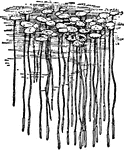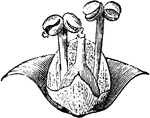Clipart tagged: ‘duckweed’

Duckweed
An illustration of duckweed. Duckweed is an important food source for waterfowl and are eaten by humans…

Duckweed
An illustration of duckweed. Duckweed is an important food source for waterfowl and are eaten by humans…

Duckweed
Common duckweed, Lemna. The entire plant is reduced to a leaf-like expansion which bears a…

Duckweed Inflorescence
An illustration of duckweed inflorescence containing two male flowers each of one stamen and a female…
Duckweeds
Duckweed is the common name of lemna minor. The fronds are usually cohering in threes and fours. The…

Lemna Minor
Pictured are floral details of lemna minor, a variety of duckweed. (aa) stamens and (b) pistil.

Lemnaoideae
Lemnaceae is a family of flowering plants, also known as the duckweed family, as it contains the duckweeds…